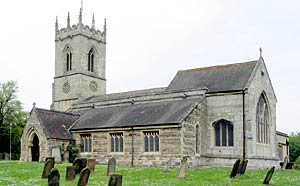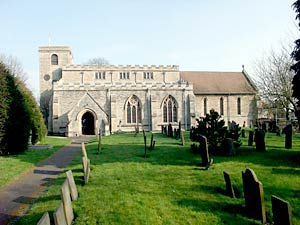< Previous | Contents | Next >
A Prime Minister's Window
ORDSALL. Straggling along a bank of the River Idle, Ordsall belongs to East Retford, but is old enough to have come into Domesday Book and has remains of three medieval centuries in its much restored church.

All Saints church. Ordsall, in 2008.
The two lower stages of the lofty tower are 14th century, with a modern west window; the two others, with a crown of battlements and pinnacles, are 15th. The 14th century nave arcades have a little 13th century work in a pillar with slender shafts, two half-pillars, and some ornament. The only old windows, apart from the tower, are two of the 15th century in the chancel, one showing Paulinus with the model of a cathedral, Mary with a book and lilies, and Hugh of Lincoln with a swan at his feet. The other, glowing richly with a scene of the marriage feast at Cana, was given by Sir John Hall, Prime Minister of New Zealand, in memory of Joseph and Catherine Hall who were married in this church in 1696, a century before the first Englishman set foot on the great southern island.
The massive oak screen across the tower arch comes from the close of the 15th century, but has been spoiled. A treasure of the church is a chalice of 1517. The bowl of an ancient font lies in the churchyard, near the base-stone of an old cross.
In a canopied wall monument a man kneels at a desk on which is an open book. He has short hair and a beard, wears rich Elizabethan dress and a ruff, and is thought to be Anthony Bevercotes of 1612. It is recorded that during the Commonwealth Marmaduke Moore was turned out of the living here for playing cards with his wife, and also that he lost his estate through treason.
The Lady of Long Ago

Orston church in 2011.
© Copyright Tim Heaton and licensed for reuse under this Creative Commons Licence
ORSTON. If we come from the hilltop we look down on its red roofs nestling in the trees. The low road, shaded by trees, brings us over two bridges, spanning the River Smite and a brook. The prettiest corner is by the stone church.
Made partly new, with a tower in the classical style of the 18th century, the church is charming inside with a clcrestoried nave and wide aisles, many big medieval windows with tracery varied and beautiful, and lancets in the 13th century chancel which has its old piscina and a priest's doorway.
Except for two 13th century round pillars on the north side, the nave arcades are 600 years old. Much of the nave roof, with its bosses, is 500 years old, and fine timbering a hundred years older still is over two bays on the north aisle. There is a Tudor chest. The font of 1662 has winged heads of three cherubs, a nosegay of flowers, and three tulips in a pot set in the middle of a flower, perhaps representing the Trinity.
A lady who must have been very beautiful six centuries ago lies here asleep, carved in stone. Her curly head rests on a cushion sheltered by a canopy, and in her folded hands she holds a heart. She was Margaret de Ros, daughter and heiress of Giles de Badlesmere.
